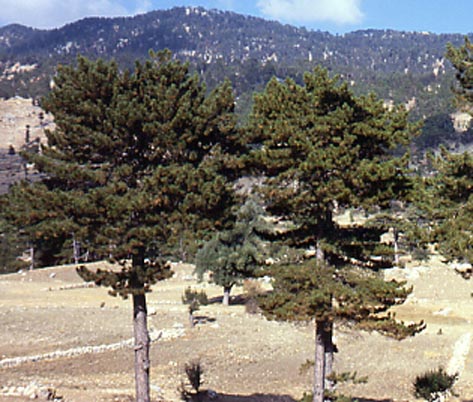- European Black Pine
Taxobox
name = European Black Pine
status = LR/lc | status_system = IUCN2.3

image_width = 240px
image_caption = European Black Pine in the wild in SW Turkey
regnum =Plant ae
divisio =Pinophyta
classis = Pinopsida
ordo =Pinales
familia =Pinaceae
genus = "Pinus"
subgenus = "Pinus"
species = "P. nigra"
binomial = "Pinus nigra"
binomial_authority = J.F.ArnoldThe European Black Pine "Pinus nigra" (generally called Black Pine in Europe), is a variable species of
pine , occurring across southernEurope fromSpain to theCrimea , and also inAsia Minor ,Cyprus , and locally in theAtlas Mountains of northwestAfrica . It is found at elevations ranging from sea level to 2,000 m, most commonly from 250–1,600 m.It is a large
tree , growing to 20–55 m tall at maturity. The bark is grey to yellow-brown, and is widely split by flaking fissures into scaly plates, becoming increasingly fissured with age. The leaves ("needles") are in fascicles of two, dark green, and 8–20 cm long. The ovulate and pollen cones appear from May to June. The mature seed cones are 5–10 cm long, with rounded scales; they ripen from green to pale yellow-buff in September to November 18 months after pollination. The winged seeds are wind-dispersed when the cones open from December to April. Sexual maturity is reached at 15–40 years; large seed crops are produced at 2–5 year intervals. It is moderately fast growing (30–70 cm/year) and usually has a rounded conic form, becoming irregular with age; it is fairly long lived, with some trees probably over 500 years old. It is intolerant of shade and needs full sun to grow well, but is resistant to snow and ice damage.The species is divided into two subspecies, each further subdivided into three varieties:
* "Pinus nigra" subsp. "nigra" in the east of the range, fromAustria , northeast and centralItaly , east to the Crimea andTurkey
** "Pinus nigra" subsp. "nigra" var. "nigra" Austrian Pine
** "Pinus nigra" subsp. "nigra" var. "caramanica" Turkish Black Pine
** "Pinus nigra" subsp. "nigra" var. "pallasiana" Crimean Pine
* "Pinus nigra" subsp. "salzmannii" in the west of the range, from southItaly to southFrance ,Spain and northAfrica
** "Pinus nigra" subsp. "salzmannii" var. "salzmannii" Cevennes Black Pine
** "Pinus nigra" subsp. "salzmannii" var. "corsicana" (syn. subsp. "laricio") Corsican Pine, Calabrian Pine
** "Pinus nigra" subsp. "salzmannii" var. "mauretanica" Atlas Mts Black PineInEurope andAsia Minor trees usually associated with this species includeScots Pine ("Pinus sylvestris"),Serbian Spruce ("Picea omorika"),Bosnian Pine ("P. heldreichii"),Norway Spruce ("Picea abies"),Lebanon Cedar ("Cedrus libani"),European Silver Fir ("Abies alba") and relatedfir s, several species ofjuniper ("Juniperus" spp.), and various broadleaf trees.The wood is similar to that of Scots Pine and
Red Pine ("P. resinosa"), being is moderately hard and straight-grained. It does however tend to be rougher, softer, and not as strong, due to its faster growth. It is used for general construction,fuel , and inpaper manufacture.Different provenances (seed sources by geographic area) or varieties are adapted to different soil types:
Austria n andPyrenees origins grow well on a wide range of soil types, Corsican pine grows poorly onlimestone , while Turkish andCrimea n origins grow well on limestone. Most provenances also show good growth onpodzol ic soils. The eastern subsp. "nigra" exhibits greater winter frost hardiness (hardy to below −30°C) than the western subsp. "salzmannii" (hardy to about −25°C).In the
United States , European Black Pine is of little importance as atimber species. It is planted mainly for shelterbelts, as a street tree, and as an ornamental. It is recommended for windbreaks in the Northern Great Plains on medium to deep moist or upland soils. Its value as a street tree is largely due to its resistance to salt spray (from road deicing salt) and various industrial pollutants (includingozone ), and its intermediate drought tolerance. Most of the European Black Pine planted in the United States is from Austrian sources. It has become naturalised in a few areas of the United States. InNew Zealand it is considered a pest weed species (alongsidePinus contorta andPinus sylvestris ) due to their invasive nature within areas of tussock grassland.References
*
External links
* [http://www.conifers.org/pi/pin/nigra.htm Gymnosperm Database: "Pinus nigra"]
* [http://www.pinetum.org/PhotoMPF2.htm photos of trees in the wild in SW Turkey]
* [http://www.fs.fed.us/database/feis/plants/tree/pinnig/all.html FEIS database (US govt)] (parts of the text above excerpted from here; further details may be found here)
Wikimedia Foundation. 2010.
